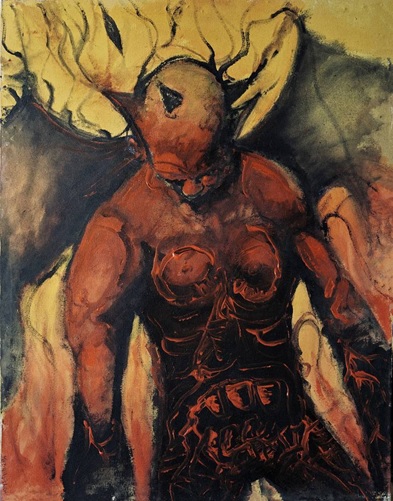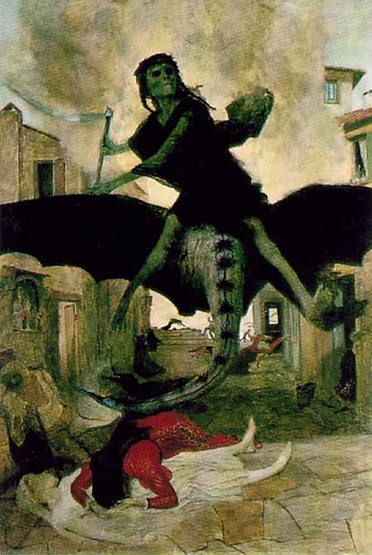Devil paintings have always intrigued artists of all generations. Some of the most common devil paintings widely admired include the lucifer and satan.
There is a wide variety of devil paintings that narrate different mythological and biblical stories. These demon paintings were among the very high-priced paintings and remained so to date.
The famous paintings of fell have a special place on this planet. Hence, tap into this lucrative segment to know more about the angels and demon paintings.
 Dante et Virgile au Enfers (Dante & Virgil In Hell) By William Adolphe Bouguereau
Dante et Virgile au Enfers (Dante & Virgil In Hell) By William Adolphe Bouguereau
William Adolphe Bouguereau painted Dante and Virgil in 1850, and it was put on display at the Musee d’ Orsay in Paris. The painting is a depiction of a scene from Dante’s divine comedy. It narrates a journey through hell by Dante and his guide Virgil.
The scene portrays the author and guide as two damned souls in eternal combat. Out of the two, one soul is an alchemist and heretic named Capocchio. He is bitten on the neck by the trickster called Gianni Schicchi.
At that time, the work was not appreciated by the critics. William, however, succeeded in his efforts later when his other work won the consolation second prize of the year. It was Shepherds Find Zenobia on the Banks of the Araxes.
Lucifer By Franz Von Stuck
The German artist Franz Von Stuck painted Lucifer in 1890. The Lucifer renaissance painting artist was the founder of Munich succession. The canvas of this everlasting beauty measures 161 by 152.5 cm.
The painting is a depiction of the dark monumental period. It presents an image of a male demon. In this one, Franz focussed on Symbolism to present the idea of duality and the nature of humanity through this lucifer painting.
The artwork seems to imply that humans need no external or supernatural source of evil. Instead, each of us carries a spark of devil energy within ourselves. With this luminous painting, he painted a demon Lucifer, beautiful in Heaven.
The Plague By Arnold Bocklin
In 1898, Arnold Bocklin painted this exceptional demon artwork in tempera by putting more light on the Swiss symbolism techniques. The artwork exemplifies the artist’s obsession with nightmares of war, death, and pestilence.
The realistic demon painting captures a bat-like winged creature who travels through the streets of a medieval European town. The main idea of the painting is a condition where the Plague is hit.
The painting is rendered in shades of pale green, often seen as symbolic of decomposition. The other predominant tones in the painting represent the strokes of black and dull browns.
These can be seen in the clothes worn by the figures in the middle and background. The only vivid color shown is the red cloth of the woman in the mid-foreground. She lies across the corpse of a woman who was also cut down by evil.
 The Nightmare By Johann Henry Fuseli
The Nightmare By Johann Henry Fuseli
The Swiss artist Johann Henry Fuseli painted this devilish yet iconic piece of art in 1781. Henry painted a woman lying in a deep sleep with arms thrown below her. One can see a demonic, ape-like incubus crouched on her chest.
The painting was hugely successful because of its dreamlike and haunting erotic evocation. The infatuation and obsession gained popular hype and a lot of appreciation from critics. Moreover, the patrons amplified the horrified fascination to the extent that it was parodied until it was bracketed as a political satire.
The engraved version got widely distributed in return for the massive response. Fuseli produced at least three other versions of similar genres. Although the interpretations varied, the canvas simultaneously portrayed similar narratives.
In the painting, the horse head and the incubus refer to contemporary beliefs and folklore about nightmares. But, more specifically, the meanings by some theorists and contemporary critics were taken aback. It was so because of the high sexuality quotient of the painting.
The Demon Seated By Mikhail Vrubel
The Russian artist Mikhail Vrubel lived and worked on different genres of art in the 19th century. What attracted him the most was the subject of supernatural, angels, and demon art.
In the early centuries, especially before the 19th, most artists preferred works that could be directly tied back to the Christian church. They were stories from the Bible or narratives with strong fictional noble vs. demon characters.
But Vrubel was one artist who chose to depict his idea of a demon through The Demon Seated. It seemed to be a more personal and believable manner than other artists compared to other artists of his time.
The painting depicts a demon sitting on a hillside with legs tucked up close to his body. It seems as if he’s seeking comfort from some torment. In this work, he used large amounts of bold, dark coloration to symbolize the demon’s power.
The Bottom Line
While some age-old artists concentrated on famous demons, all of these lie in ourselves; at the same time, others depicted them through fictional characters inspired by the Bible. But, what always intrigued the critic was the narrative, technique, and beauty in the evil. You can find all such paintings online and select the ones you like the best.


